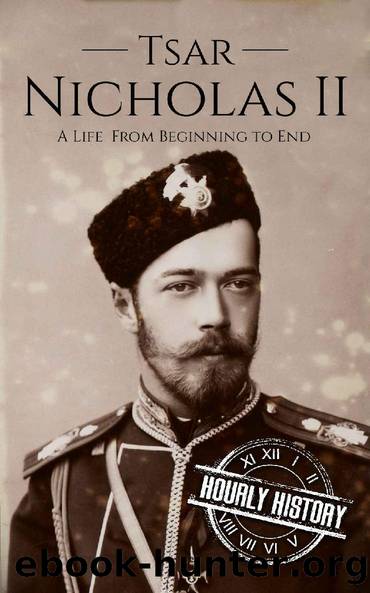Tsar Nicholas II: A Life From Beginning to End (Biographies of Russian Royalty Book 2) by Hourly History

Author:Hourly History [History, Hourly]
Language: eng
Format: epub
Publisher: Hourly History
Published: 2017-12-13T00:00:00+00:00
Chapter Seven
Nicholasâ Reluctant Reforms
âThe ability to compromise is not a diplomatic politeness toward a partner but rather taking into account and respecting your partnerâs legitimate interests.â
âVladimir Putin
After 1905, Russia was plagued with endless unrest, strikes, and protests. Still, remaining aloof and unbothered, their leader Nicholas II carried on with his life as if he didnât have a care in the world. He continued his idyllic existence in the countryside with his young family regardless of the turmoil in the city streets of Russia. If he had been paying closer attention, he would have noticed a decided shift in the sentiment of the protesters.
Those who had been pleading with the tsar as a benevolent ruler they respected, were now, after Bloody Sunday, directly addressing him as the problem and were demanding radical reform if not his outright removal from office. St. Petersburg became the focal point of this radicalization and over the decade prior to the 1917 revolution that would spark the Soviet Union, St. Petersburg became known as the first official soviet.
In Russian, soviet means council, so calling St. Petersburg a soviet meant that it had become the headquarters and council of the labor unions and workers frequently out on strike. But even more than a place to organize strikes and demonstrations, this soviet soon took on the form of a populist government in itself and became a direct forerunner of the kind of representative body that the working class of Russia wished to create.
But rather than support their efforts, the tsar sought to have them shut downâimmediately. As soon as one of these revolutionary councils emerged, the tsar moved to put them out of business. But soon, his inner circle became alarmed enough to advise Nicholas to consider meeting some of their demands, especially the idea of letting them have their own representative body, which the Russians referred to as a Duma.
But these ideas of reform were abhorrent to Tsar Nicholas II. As unbelievable as it may sound, in the tsarâs mind, the sudden unrest was not a sign that the country needed reform, it was a sign that they needed God. After his ministers broached the topic of reform, the deeply religious tsar scoffed at the notion that it was poor living conditions that drove the people to demonstrate in the streets. Instead, Nicholas believed that it was a severe lack of social discipline that led to the public turmoil.
Rather than being moved to reform, Nicholas considered that such things were a sign that the people needed an even firmer hand to guide them in the right direction. Perhaps in his existential crisis, the tsar was harkening back to his authoritarian father Alexander III, but if Nicholas thought that a last-minute attempt to channel the ghost of his hardline father would quell the unrest, he was gravely mistaken.
Things soon became so turbulent and out of control that the military could barely stave off an all-out societal collapse. In a desperate attempt to demonstrate this point, the commander of the St.
Download
This site does not store any files on its server. We only index and link to content provided by other sites. Please contact the content providers to delete copyright contents if any and email us, we'll remove relevant links or contents immediately.
Blood and Oil by Bradley Hope(1531)
Wandering in Strange Lands by Morgan Jerkins(1374)
Ambition and Desire: The Dangerous Life of Josephine Bonaparte by Kate Williams(1347)
Daniel Holmes: A Memoir From Malta's Prison: From a cage, on a rock, in a puddle... by Daniel Holmes(1295)
It Was All a Lie by Stuart Stevens;(1265)
Twelve Caesars by Mary Beard(1258)
The First Conspiracy by Brad Meltzer & Josh Mensch(1140)
What Really Happened: The Death of Hitler by Robert J. Hutchinson(1131)
London in the Twentieth Century by Jerry White(1114)
Time of the Magicians by Wolfram Eilenberger(1091)
The Japanese by Christopher Harding(1086)
Twilight of the Gods by Ian W. Toll(1085)
Cleopatra by Alberto Angela(1063)
A Woman by Sibilla Aleramo(1055)
Lenin: A Biography by Robert Service(1046)
The Devil You Know by Charles M. Blow(987)
Reading for Life by Philip Davis(974)
1965--The Most Revolutionary Year in Music by Andrew Grant Jackson(925)
The Life of William Faulkner by Carl Rollyson(925)
